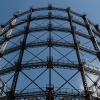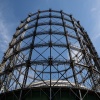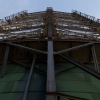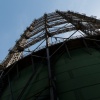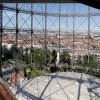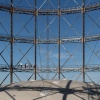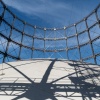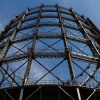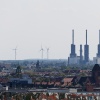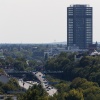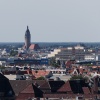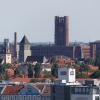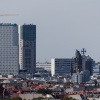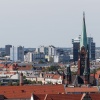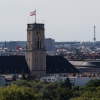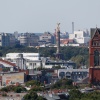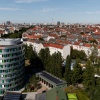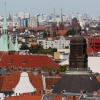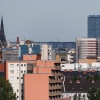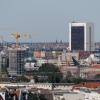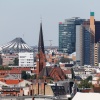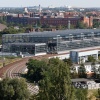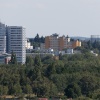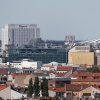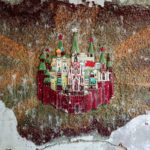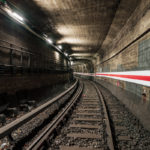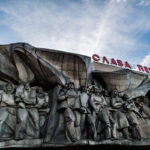Gasometer – Berlin-Schöneberg’s steel skeleton
Hip and cool Berlin can be pretty shallow as with having a highest elevation of only ~100 metres it’s generally got a very flat topography. And since German megalomania once also regulated the maximum height for residential buildings, it is very easy to overlook whole Berlin when standing on elevated places. One of those spots peeping out of the ocean of houses is Berlin-Schöneberg-based Gasometer, an industrial relict once used to store gas but that can be climbed today..
All zoomed-in photos originate all Canon’s wonderful EF 200-400 f/4, a stellar lens, that can’t equalise physics though, for example at strong sun radition causing quite some mirage (fuzzy air).
When having a look at the list of Berlin’s highest natural elevations, then you’ll quickly notice that most of them are rubble mountains, originating from World War II. Means, before the war Berlin was even flatter then it is nowadays. Urban development was governed by so called Hobrecht-Plan, that established a maximum eaves height for residential buildings of 20 metres. In 1887 that boundary got raised by 2 metres to become 22 metres in total, a limit that was valid for long long time. Only church towers where allowed to stick out by more than 80 metres.
With its height of 78 metres, Berlin-Schöneberg’s Gasometer remarkably sticks out of the surrounding houses playing in the league of church towers. Further south in Lankwitz it’s even got a smaller brother, that can’t be climbed though. The rooftop apartment of the Gasometer is taken as well. Like in real life some non-native new Berliner moved in, but in this case a lovely, kind and feathered neighbour called Eurasian kestrel. To protect this wonderful animal and not disturb it, visitors are only allowed to climb at the max only until ring number four. That doesn’t mar the view as on good days in the far distance you can even spot the chimneys of the Rüdersdorf cement factory; the town where I was born.
Even German had it’s 9/11, when Günther Jauch, a German TV moderator, stopped his 4 year lasting talk show series, being broadcasted inside the Gasometer. Since 2007 the whole former GASAG area is private property now. The investor restored the Gasometer by for example removing damages from corrosion, but its plans are not undisputed like the existence of a strong local initiative shows. And, to be honest, the investing gents and their servants were not really kind and likeable when I approached them.
The territory lies in-between three rail tracks. Yes, correct, three. Two of them are in operation, that is the Ringbahn (circular line) and S1, and the third one, once leading along today’s Cheruskerstraße, doesn’t exist anymore. Well, there are plans to reactivate this rail track as part of S21’s fourth construction phase as trains have to be merged between North-South and the circular line.
